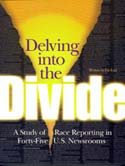Delving into the Divide: A Study of Race Reporting in Forty-Five U.S. Newsrooms
 The Marshall News Messenger is a small paper, circulation 8,000, in a small east Texas town but its 1999 project “Twelve Questions on Race” was a big idea.
The Marshall News Messenger is a small paper, circulation 8,000, in a small east Texas town but its 1999 project “Twelve Questions on Race” was a big idea.
In a town where factories segregated their shifts and some whites used the Confederate flag to keep the light out of windows, a project addressing race did not get a warm welcome.
The News Messenger’s largest advertiser withdrew his business from the paper and white ministers who participated were threatened.
But Editor Phil Latham persevered and by the end of the series, Marshall had started its first race reconciliation committee. One of the town’s most conservative white ministers had come out strongly for greater racial understanding.
Happening, as it did, in Marshall, all this did not generate any national attention. Latham’s story, in fact, might never have been known outside of Marshall.
Now, it is getting a spotlight in “Delving into the Divide: A Study of Race Reporting in Forty-five U.S. Newsrooms,” a new Pew Center publication on strategies for reporting on race.
The Pew Center hopes the book – part how-to and part case study – will provide a road map for news organizations seeking to explore growing immigration or diversity in their communities.
“Whenever I ask a room full of reporters what they could write about that would make their communities squirm, they say ‘race relations,’ ” said Jan Schaffer, the center’s executive director. “Race is a master narrative in communities around the country yet newsrooms find it tough to tell the story.
“Often, it’s hard for journalists to get their arms around something that defies conventional definitions of ‘news.’ Our hope is that this book will help journalists imagine a journalism that looks at a broader horizon and occurs over a longer time frame.”
Schaffer was inspired to publish the book after a journalism researcher – conducting an inventory of projects at the Pew Center – compiled a list of more than 30 that focused on race relations. An e-mail request to newsrooms generated dozens more.
The time seemed right to give a megaphone to new ideas for tackling the subject. The Pew Center found those newsrooms using civic journalism techniques to be in the vanguard, armed with tools well-suited to bridging the racial divides in so many U.S. communities.
Staff writer Pat Ford was assigned to synthesize the experiences of hundreds of reporters, editors, producers and news directors who worked on these projects, to determine the lessons learned in each.
The book is divided into nine broad categories that cover a range of strategies:
- Give it Time
- Take a Poll
- Identify the Issues
- Walk the Streets
- Listen to People Talk
- Debunk the Myths
- Tell your own Story
- Invite Action
- Put it on the Web
The “Give it Time” chapter, for example, looks at projects that not only drew their strength from granting generous reporting time but also took time to tell the story, whether measured in minutes on the air or weeks in the paper.
In summarizing projects comprising thousands of words and hours of air time, Ford had to make the same difficult decisions the project reporters had to make about what material to leave out and what was most instructive about a particular effort.
The projects in the book are by no means an all-inclusive list but they do represent many of the advances that have become hallmarks of contemporary race reporting. And they include some of the most sophisticated reporting on the subject. Notable is an ahead-of-its-time series in The Times of Trenton, NJ, exploring the impact of the self-segregation that has largely replaced conventional segregation.
The polling chapter details a poll conducted by the St. Paul Pioneer Press in five languages – believed to be the first of its kind – that sought the opinions of new immigrants rather than longtime citizens.
The issues chapter includes a list of essentials that were covered in nearly every project as well as some under-reported phenomena that are ripe for further investigation – the racial disparity in health care, the connection between race and environmental hazards, the separateness that prevails in leisure-time activities.
Many times, as with the Marshall News Messenger’s“Twelve Questions on Race,” it was the story behind the story – the one that never appeared in print or on the air – that is most compelling. Many of those stories are told for the first time in “Delving into the Divide.”
In interviewing journalists about their reports, writer Ford said she was struck by how many reporters and editors “even if they had employed generous resources and achieved fine results, seemed almost apologetic about not doing more.”
Journalist after journalist expressed regret, Ford said, that there had been a limit to the time and effort they could put into these stories, often saying, “We’re not The New York Times, you know.”
When the time came to interview Times staff members about their Pulitzer Prize-winning project, “How Race is Lived in America,” reporter Michael Winerip spoke with pride of the Times‘ commitment to the project: Thirty staff members spent 18 months on it. But, Winerip added, it had been a struggle to free up those resources.
“There was a lot of griping by the desks,” he said. “As many resources as the Times has, we never have enough.”
“Ambitious projects on critical subjects are always a stretch,” Ford said. “But if the newspaper has determined that race is worthy of an extraordinary effort, both the news organization and the community will benefit.”
To order a free “Delving into the Divide,” contact the Pew Center at news@pccj.org.
